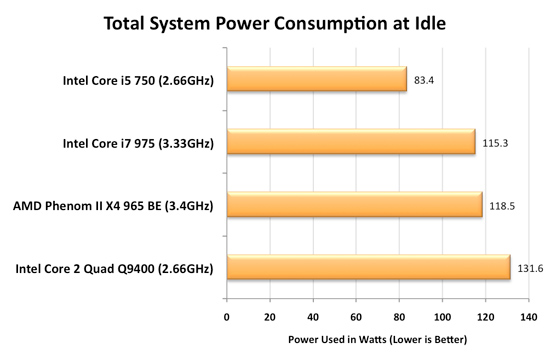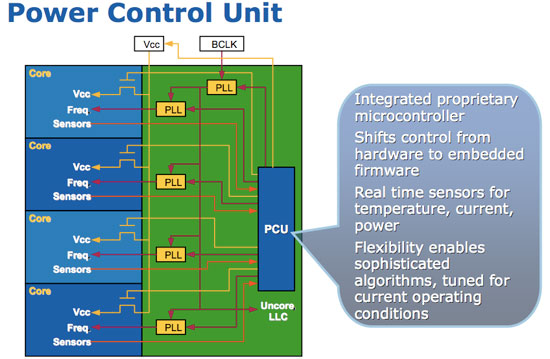Intel's Core i7 870 & i5 750, Lynnfield: Harder, Better, Faster Stronger
by Anand Lal Shimpi on September 8, 2009 12:00 AM EST- Posted in
- CPUs
Homework: How Turbo Mode Works
AMD and Intel both figured out the practical maximum power consumption of a desktop CPU. Intel actually discovered it first, through trial and error, in the Prescott days. At the high end that's around 130W, for the upper mainstream market that's 95W. That's why all high end CPUs ship with 120 - 140W TDPs.
Regardless of whether you have one, two, four, six or eight cores - the entire chip has to fit within that power envelope. A single core 95W chip gets to have a one core eating up all of that power budget. This is where we get very high clock speed single core CPUs from. A 95W dual core processor means that individually the cores have to use less than the single 95W processor, so tradeoffs are made: each core runs at a lower clock speed. A 95W quad core processor requires that each core uses less power than both a single or dual core 95W processor, resulting in more tradeoffs. Each core runs at a lower clock speed than the 95W dual core processor.
The diagram below helps illustrate this:
| Single Core | Dual Core | Quad Core | Hex Core | |
| TDP |  |  |  |  |
| Tradeoff |  |  |  |  |
The TDP is constant, you can't ramp power indefinitely - you eventually run into cooling and thermal density issues. The variables are core count and clock speed (at least today), if you increase one, you have to decrease the other.
Here's the problem: what happens if you're not using all four cores of the 95W quad core processor? You're only consuming a fraction of the 95W TDP because parts of the chip are idle, but your chip ends up being slower than a 95W dual core processor since its clocked lower. The consumer has to thus choose if they should buy a faster dual core or a slower quad core processor.
A smart processor would realize that its cores aren't frequency limited, just TDP limited. Furthermore, if half the chip is idle then the active cores could theoretically run faster.
That smart processor is Lynnfield.
Intel made a very important announcement when Nehalem launched last year. Everyone focused on cache sizes, performance or memory latency, but the most important part of Nehalem was far more subtle: the Power Gate Transistor.
Transistors are supposed to act as light switches - allowing current to flow when they're on, and stopping the flow when they're off. One side effect of constantly reducing transistor feature size and increasing performance is that current continues to flow even when the transistor is switched off. It's called leakage current, and when you've got a few hundred million transistors that are supposed to be off but are still using current, power efficiency suffers. You can reduce leakage current, but you also impact performance when doing so; the processes with the lowest leakage, can't scale as high in clock speed.
Using some clever materials engineering Intel developed a very low resistance, low leakage, transistor that can effectively drop any circuits behind it to near-zero power consumption; a true off switch. This is the Power Gate Transistor.

On a quad-core Phenom II, if two cores are idle, blocks of transistors are placed in the off-state but they still consume power thanks to leakage current. On any Nehalem processor, if two cores are idle, the Power Gate transistors that feed the cores their supply current are turned off and thus the two cores are almost completely turned off - with extremely low leakage current. This is why nothing can touch Nehalem's idle power:

Since Nehalem can effectively turn off idle cores, it can free up some of that precious TDP we were talking about above. The next step then makes perfect sense. After turning off idle cores, let's boost the speed of active cores until we hit our TDP limit.

On every single Nehalem (Lynnfield included) lies around 1 million transistors (about the complexity of a 486) whose sole task is managing power. It turns cores off, underclocks them and is generally charged with the task of making sure that power usage is kept to a minimum. Lynnfield's PCU (Power Control Unit) is largely the same as what was in Bloomfield. The architecture remains the same, although it has a higher sampling rate for monitoring the state of all of the cores and demands on them.
The PCU is responsible for turbo mode.










343 Comments
View All Comments
mschira - Tuesday, September 8, 2009 - link
I wonder if a 4xPCIe RAID adapter directly connected to a PCIe slot that is connected to the CPU is any faster than it is for a Core i7 920....Cheers
Gary Key - Tuesday, September 8, 2009 - link
Less than a one percent difference in my testing so far.Jamahl - Tuesday, September 8, 2009 - link
Why do your benches falsely state 2.66ghz when they are clearly running faster than that?rbbot - Tuesday, September 8, 2009 - link
lol - I've just been berating a reviewer on another site for benchmarking with turbo off! In that case the review wasn't targeted at an overclocking audience, but even here I can't see the argument for benchmarking with it disabled.Yes you do need to turn it off for extreme overclocking, but this review is comparing the chips in their stock configuration and stock configuration is on.
maxxcool - Tuesday, September 8, 2009 - link
As for false, well gee, you were told it was on. Didn't you read that? or are you snakeoils brother?goinginstyle - Tuesday, September 8, 2009 - link
They list the base CPU speeds, it was discussed clearly in the article that turbo is enabled, it is not a false statement for reporting what you will purchase. Apparently you just want to flame bait here and I hope they ban you and the two other nut jobs.rgallant - Wednesday, September 9, 2009 - link
people see what they want to see I guess-I wanted to see the multi gpu test, 1156 vs 1366 , clock vs clock ,fps vs fps ,16x vs 8x on die , not one chip overclocking it's self unless you show the numbers for turbo on and off, what if the 1366 mb used for the benches came out of the box and by the default bios overclocked the i7 920 to 3.8 ,would those numbers be included as stock out of the box. I don't think so , that feature would be turned off on the mb.for the benches. 1156 numbers could mean nothing really.
-all cpu's should been locked at 3.6 at least for the multi gpu test or one test anyways.
-the 8x 8x lane issue is the only crippled feature on the new chips ,and it seems to take a back seat to the $50.00 savings for a mb for a $600.00 i7 870 chip ,or $900.00 CND .lol On sept.05 my local shop had the i7 920 D0 and the i7 860 both at $345 CND.
-good review as always ,just missing that part for me , looking to commit on a 1156 or a 1366 upgrade.
maxxcool - Tuesday, September 8, 2009 - link
Yeah, you got to get rid of snakeoil, he is quiet the troll on the TechReport forums as well. He has been banned from several sites already.andrenb91 - Tuesday, September 8, 2009 - link
i5 is faster than PII's! but gotta wait for the lower end ones come outbecause these $190+ chips aren't the one ones that brings up revenue for companies like amd or intel...of course intel has the upper hand here, it could use as a propaganda do deliver up the slower parts. Amd has value and some good cpus at the lower end... that ones bring profits to the company,amd strategy is looking good for now, but it's design must change (native dual/tripe core versions of Phenom II) and the die size have to get smaller to compete next year (against 32nm low end ones...) well I use amd budget ones, for what I do is good enough, ( thin about $400 pc in USA, live in Brazil...) still, I can play some 40fps games and do some video encoding with my gpu,my point is, amd still have the lower-end market, the problem is, if were some of that people that think pentium is a company name, I would by the pentium cpus instead of amd strange cpus. that's why intel sells a lot more desktops and notebooks, of course the performace is great at some 700+ pcs and laptops, but amd has the lower-end, and there it is what amd is looking for: market share, and taht will pump amd back again by 2011 with its fusion apu, intel already controls 80% of mainstream,and high-end markets, but doesn't have a player for the lower-end, thats what I'm looking for a good old intel cpu that beats p2x3 or athlonIIx4 by intel at about $100. then I'll buy my next cpu, probably an intel, or continue with Amd, time will tell...
andrenb91 - Tuesday, September 8, 2009 - link
sorry for my english and, these benchmarks are for windows only, over linux intel i5 will not have this crazy advantage at all, well but who of us uses linux anyway?(don't lie to me, it's a dual boot...) well my system specs are: phenomII x3 705e,4gb ddr3 1333,hd 4650 basicaly a low-end to mainstream..